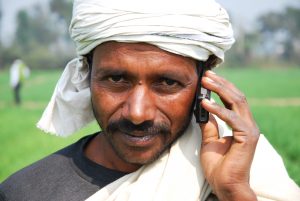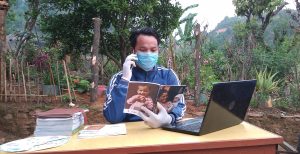Situation Assessment of the Rural Economy amid COVID-19 Crisis: Evidence from India
The COVID-19 induced lockdown has sent a shockwave across the Indian economy. Analysts have now pegged the gross domestic product (GDP) degrowth in the second quarter of 2020 at 40-45%. Against this bleak backdrop, agriculture has remained a bright spot, recording a bumper harvest in the recently concluded rabi season and even a small increase in employment. What is the outlook of the agricultural sector going forward, and have the proposed relief measures provided farmers the support they need? In this blog, the authors use primary phone survey data collected in April-May 2020 from three large northern states to provide some preliminary answers to these questions. – Kalyani Raghunathan, series co-editor and Research Fellow at IFPRI

Pre COVID-19, a farmer speaks on his mobile telephone while at work in a wheat field close to the Pusa site of the Borlaug Institute for South Asia (BISA), in the Indian state of Bihar.
Photo credit: M. DeFreese/CIMMYT.
The economic slowdown caused by COVID-19 crisis and the subsequent lockdown has severely affected the Indian economy. According to the 2011 Census, two-third Indians – about 833 million individuals – reside in rural areas and depend on agriculture for their livelihoods. Agriculture accounts for 16% of India’s GDP. Unlike other sectors, the agriculture sector has performed well despite COVID-19, recording a bumper harvest in the rabi season during 2019-2020, with 5% rise in cereal production since the previous year, increasing from 129.7 million tons to 136.7 million tons. Given the minimum support price (MSP) of wheat, at the rate of INR 1,925 per quintal, wheat alone contributes 2.06 lakh crore (4%) to the country’s GDP.
However, the major chunk of activities related to rabi cultivation were completed before the nation-wide lockdown was announced on March 24, 2020. The subsequent slowdown in economic activity as a result of the lockdown raises several important research questions: what happens to post-production activities such as agricultural marketing for the rabi crop? What challenges did farmers face in the procurement of agricultural inputs such as fertilizers, pesticides, seeds, agricultural machineries and labor for the upcoming kharif season?
To provide answers to some of these questions, we use insights from a phone survey conducted in the month of April-May 2020 in the states of Rajasthan, Madhya Pradesh and Uttar Pradesh. In the context of these results, we then assess the efficacy of the Pradhan Mantri Garib Kalyan Yojana (PM-GKY), a relief package announced by the Government of India (GoI) in March 2020, with the intention to provide immediate support to vulnerable Indians during the COVID-19 crisis.
On-ground assessment of the situation of farmers
The states of Rajasthan, Madhya Pradesh and Uttar Pradesh together account for 28% of the total population of the country and are home to 93.5 million poor. Our survey covered 1,868 households from 346 villages of 51 districts, representing all agro-ecological zones of these states.
93% farmers in our sample were men, of which 25% belonged to the Scheduled Caste/Tribe categories, and 82% reported agriculture as their primary occupation. 42% had access to formal credit through the Kisan Credit Card (KCC) scheme. Distribution of farmers by land size suggests that the small and marginal farmers constitute the majority, with 66% farmers owning less than 1 hectare of land. 5.7% farmers reported no cultivation in the 2020 rabi season.
We found that only 20% farmers had been able to sell their produce, which is not surprising given the nation-wide lockdown in the month of April. Other authors have also reported slow rates of procurement in April, with a subsequent recovery in May and June. Our field reports suggest that the state governments started procurement using online registration, token distribution, and SMS alerts to farmers telling them when to report to the procurement center to sell their produce. 19% farmers growing wheat were able to sell their produce, as compared to 52% mustard and 45% gram growing farmers. One plausible explanation for this disparity across crops could be the increased supply of wheat due to the provision of free ration in the first government-provided COVID-19 relief package.
We asked farmers about their concerns regarding the availability of agricultural inputs for the upcoming kharif season. 32% said they were concerned about the availability of agricultural machinery, followed by fertilizer and pesticides (30%), agricultural labor (18%), and seeds (3%).
Effectiveness of PM-GKY relief measures
The INR 1700 billion (USD 22.7 billion) PM-GKY was announced in March 2020 and provides direct benefit transfers (DBT) and in-kind support (IKS) to the vulnerable sections. The DBT component of the package includes:
- Release of the first installment of INR 2000 (USD 27) to 87 million farmers under the Pradhan Mantri Kisan Samman Nidhi (PM-KISAN) scheme in April 2020,
- Three installments of INR 500 (USD 7) each for 200 million women account holders through the Pradhan Mantri Jan Dhan Yojana (PM-JDY)for the months of April, May and June 2020,
- Three installments to 80 million beneficiaries to buy LPG cylinders for three months, under the Pradhan Mantri Ujjwala Yojana (PM-UY) for the months of April, May and June 2020, and
- Three installments of INR 1000 (USD 14) to 30 million senior citizens, widows and disabled persons for the months of April, May and June 2020.
The IKS component includes 5 kg free wheat/rice to every individual and 1 kg pulses to every household, reaching 800 million people for the months of April, May, and June 2020.
We found that many of these benefits had successfully reached the eligible beneficiaries in the month of April. 89% eligible farmers received INR 2000 (USD 27) under the PM-KISAN scheme. In the present situation, where liquidity is already low, this emergency relief is likely to provide much-needed support for continued agricultural activities, especially to the small and marginal farmers. 92% eligible beneficiaries received INR 500 (USD 7) under the PM-JDY scheme, 94% received DBTs to obtain their allotted free-of-cost LPG cylinders, 90% received the INR 1,000 (USD 14) promised to senior citizens, widows and disabled persons, and 76% received the free ration of wheat/rice and pulses.
Finally, our survey results indicated that there is a need to strengthen the supply chain, for instance, by linking more farmers with electronic agricultural markets. Some welcome steps announced by the Government of India in May 2020 include the formation of 10,000 farmer producer organizations and the linking of 177 new agricultural markets with the electronic National Agriculture Marketing (e-NAM) scheme. The e-NAM scheme is a pan-India electronic trading portal that gives buyers and sellers an opportunity to trade their commodities using real time prices. Moreover, there is a need to ensure uninterrupted supply of agricultural inputs such as machinery, fertilizer and pesticides.
Conclusion
Our analyses of the disbursement of DBTs and IKS in these three states show that the emergency relief is reaching the small and marginal farmers, women, senior citizens, widows and disabled persons, and other marginalized communities. Lower transaction costs, minimal leakages, and immediate delivery make a strong case for DBTs, and facilitate rapid relief to a large proportion of these communities. What remains to be seen is how effective would these relief measures be in sustaining its reach to those who need it the most. Also, what’s important to see is, whether these measures would be enough to ensure a smooth functioning of production activities in the upcoming kharif season.
Deepak Varshney is Research Collaborator, International Food Policy Research Institute (IFPRI). Anjani Kumar is Senior Research Fellow, IFPRI. P.K. Joshi is Hon. Director, Agriculture Economics Research Centre (AERC), University of Delhi. The analysis and opinions expressed in this piece are solely those of the authors.
This blog has been published as a part of the International Food Policy Research Institute (IFPRI), South Asia, blog series on analyzing the impacts of the COVID-19’s pandemic on the sub-national, national, and regional food and nutrition security, poverty, and development. To read the complete blog series click here
New research from a Special Issue of Applied Economic Perspectives and Policy
The pandemic caused disruptions to both the supply of and demand for health services that persisted past the lifting of lockdown measures.
Public food transfer programs have traditionally been the most common social protection programs in Bangladesh


